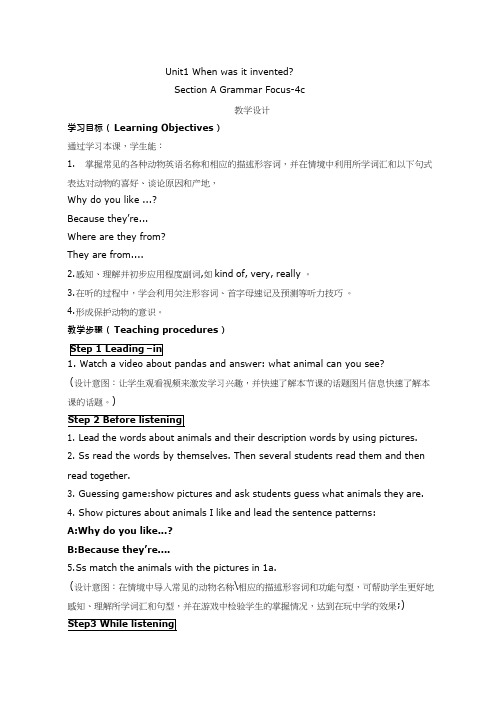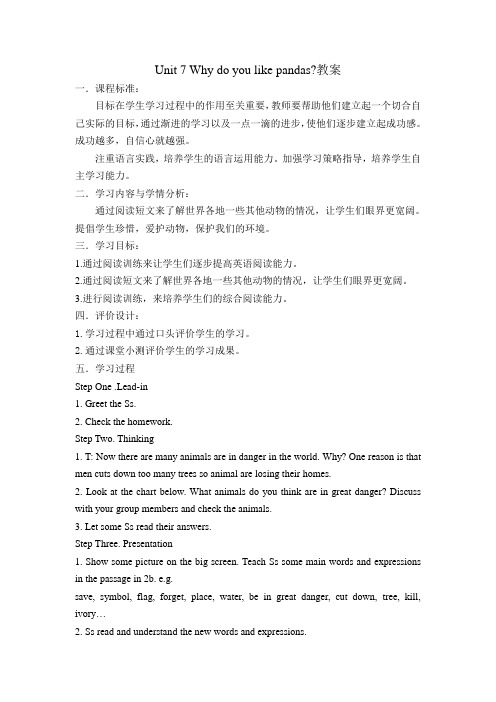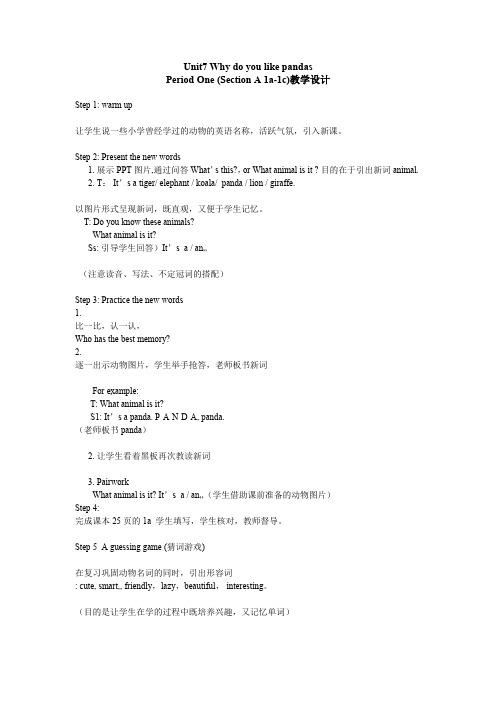初中英语《Unit 7 why do you like pandas》优质课教案、教学设计
- 格式:docx
- 大小:11.68 KB
- 文档页数:4

Unit7 Why do you like pandas? Section A(1a-2c)教学设计一、教学目标:(一).知识目标:1 能够听、说、读、写本课的重点单词和短语:panda,tiger, elephant, koala, lion, giraffe, animal, zoo, cute, lazy, smart, beautiful, scary.2.能够熟练掌握本课重点句型:Why do you...? Because ...Let’s do..., Where are they from?(二)、能力目标:1.能够听懂课文中活动的录音;2.能够掌握本课重点句型的表达。
(三)情感目标:1.通过学习本课内容,让学生在自己的内心世界当中形成关爱动物,保护动物的观念,动物是人类的朋友。
2.通过听力活动提高学生学习英语的兴趣。
二、教学重点:1.能够听、说、读、写重点单词和短语:panda, zoo, tiger,elephant, koala, lion, giraffe, animal, cute, lazy,smart,beautiful, scary.2.能够熟练掌握本课重点句型:Why do you...? Because ...Let’s do..., Where are they from?三、教学难点:1.听力技能的掌握。
2.句子的升降调。
四、教学用具:课件、课本。
五、教学过程:1.Warming-upGreetings: T:How are you? Boys and girls!Ss: I’m fine ,thank you, and you?T:I’m fine too.2.Leading inListen to a song “Macdonald had a farm”, then ask students “There are some animals in this song, what are t hey?”Ss: They are chicks, ducks, cows…T:Where can we see more animals?Ss: In the zoo.3.Presentation1)教师出示动物园及动物图片让学生来表达图片所示内容,教师以提问的形式和学生一问一答:T: What is it? S: It is tiger.T:What are they? S:They’re tigers.以同样的方式提问以下几种动物。

Step 1 Leading –inUnit1 When was it invented?Section A Grammar Focus-4c教学设计学习目标( Learning Objectives )通过学习本课,学生能:1. 掌握常见的各种动物英语名称和相应的描述形容词,并在情境中利用所学词汇和以下句式表达对动物的喜好、谈论原因和产地,Why do you like ...?Because they’re...Where are they from?They are from....2. 感知、理解并初步应用程度副词,如 kind of, very, really 。
3. 在听的过程中,学会利用关注形容词、首字母速记及预测等听力技巧 。
4. 形成保护动物的意识。
教学步骤( Teaching procedures )1. Watch a video about pandas and answer: what animal can you see?(设计意图:让学生观看视频来激发学习兴趣,并快速了解本节课的话题图片信息快速了解本课的话题。
)1. Lead the words about animals and their description words by using pictures.2. Ss read the words by themselves. Then several students read them and then read together.3. Guessing game:show pictures and ask students guess what animals they are.4. Show pictures about animals I like and lead the sentence patterns:A:Why do you like...?B:Because they’re....5. S s match the animals with the pictures in 1a.(设计意图:在情境中导入常见的动物名称\相应的描述形容词和功能句型,可帮助学生更好地感知、理解所学词汇和句型,并在游戏中检验学生的掌握情况,达到在玩中学的效果;)1.Listen and check animals you hear in 1a..2.Check answers one by one.3.Listen and match the description words. Pay attention to the description words when listening.4.Listen and repeat.5.Pairwork: A:Let’s see the...B: Why do you want to see them?A: Because they are....6.L et Ss guess what animals I don’t like and lead the usage of really, scary and kind of by showing pictures.7.S how pictures to lead the sentence patterns:A: Where are .... from?B: They’re from...8.Create a situation. Ask Ss to listen and write the animals. Pay attention to writing the first letters of the animals.9.Listen again and draw lines from the animal to the description words and the coutries they are from.10.Predict 2b. Then listen and complete the conversation in 2b. Pay attention to the tip of prediction.(设计意图:在1b 的基础之上增设听力任务,让学生们更加关注描述形容词的使用;通过听力任务,进一步感知理解如何表达对动物的喜好、谈论原因和产地。



Unit 7 Why do you like pandas?教案一.课程标准:目标在学生学习过程中的作用至关重要,教师要帮助他们建立起一个切合自己实际的目标,通过渐进的学习以及一点一滴的进步,使他们逐步建立起成功感。
成功越多,自信心就越强。
注重语言实践,培养学生的语言运用能力。
加强学习策略指导,培养学生自主学习能力。
二.学习内容与学情分析:通过阅读短文来了解世界各地一些其他动物的情况,让学生们眼界更宽阔。
提倡学生珍惜,爱护动物,保护我们的环境。
三.学习目标:1.通过阅读训练来让学生们逐步提高英语阅读能力。
2.通过阅读短文来了解世界各地一些其他动物的情况,让学生们眼界更宽阔。
3.进行阅读训练,来培养学生们的综合阅读能力。
四.评价设计:1.学习过程中通过口头评价学生的学习。
2.通过课堂小测评价学生的学习成果。
五.学习过程Step One .Lead-in1. Greet the Ss.2. Check the homework.Step Two. Thinking1. T: Now there are many animals are in danger in the world. Why? One reason is that men cuts down too many trees so animal are losing their homes.2. Look at the chart below. What animals do you think are in great danger? Discuss with your group members and check the animals.3. Let some Ss read their answers.Step Three. Presentation1. Show some picture on the big screen. Teach Ss some main words and expressions in the passage in 2b. e.g.save, symbol, flag, forget, place, water, be in great danger, cut down, tree, kill, ivory…2. Ss read and understand the new words and expressions.Step Four. Reading1. Fast readingT: Now, read the passage quickly and find the answer to this question:When is Thai Elephant Day?(March 13th.)Ss read the passage quickly and try to find the answer to this question.Check the answers.2. Careful readingT: Now read the passage again and find the answers to these questions (on the big screen):①What do the students from Thailand wan to do?②What can Elephants do?③Why are elephants in great danger?④What's the best title for this article? (check)Ss read the questions first. Then read the passage again and find the answers to the questions.Check the answers with the class.Step Five. Reading1. Tell the students to look at the map in 2c. There are four box around the word "Elephant". The first box is about the importance of the elephants in Thailand. The second box is about the abilities of the elephants. The third box is about the facts and figures of the elephants. The last box is about how to save the elephants. Let's read the passage again and fill in the blanks.2. 阅读指导:1) 认真看一遍这四个表格,明确每个表格是关于大象的那个方面的情况。

Unit7 Why do you like pandasPeriod One(Section A1a-1c)教学设计Step1:warm up让学生说一些小学曾经学过的动物的英语名称,活跃气氛,引入新课。
Step2:Present the new words1.展示PPT图片,通过问答What’s this?,or What animal is it?目的在于引出新词animal.2.T:It’s a tiger/elephant/koala/panda/lion/giraffe.以图片形式呈现新词,既直观,又便于学生记忆。
T:Do you know these animals?What animal is it?Ss:引导学生回答)It’s a/an…(注意读音、写法、不定冠词的搭配)Step3:Practice the new words1.比一比,认一认,Who has the best memory?2.逐一出示动物图片,学生举手抢答,老师板书新词For example:T:What animal is it?S1:It’s a panda.P-A-N-D-A,panda.(老师板书panda)2.让学生看着黑板再次教读新词3.PairworkWhat animal is it?It’s a/an…(学生借助课前准备的动物图片)Step4:完成课本25页的1a学生填写,学生核对,教师督导。
Step5A guessing game(猜词游戏)在复习巩固动物名词的同时,引出形容词:cute,smart,,friendly,lazy,beautiful,interesting。
(目的是让学生在学的过程中既培养兴趣,又记忆单词)Step6:Practice the description words根据学生回答,老师可在对应动物后板书形容词Step6:New drills引出语言项目(板书)同时操练形容词:-Why do you like?-Because they are...2.PairworkA:Let’s see the…sB:Why do you want to see the…s?A:Because they are…Step7:Do a survey and make a report Work in groups of three.在复习巩固动物名词的同时,引出形容词:cute,smart,scary,friendly为1才做好强烈的铺垫,让学生可以顺利的进入今天的一个难点,形容词的练习。
U n i t7W h y d o y o u l i k e p a n d a s?S e c t i o n A1a—2c教学设计设计的基本理念:根据新课标,培养学生自主、合作、探究精神、突出语言运用能力培养的理念而设计。
课型:听说课一、教材分析本单元主要是通过学习动物名称和常见的有关描述动物的形容词,学会表达个人对动物的喜好;学会运用w h y,w h a t,w h e r e引导的问句,了解动物的外形、生活习性及主要产地,并能运用英语简单描述自己喜欢的动物,进一步培养和激发热爱动物、保护动物、维护生态平衡的朴素情怀。
而本节只是学习动物名称和描述动物的形容词,并学会询问为什么及回答原因。
二、教学目标知识目标:1.识记词汇:a n i m a l,t i g e r,e l e p h a n t,g i r a f f e,p a n d a,l i o n,g i r a f f e,c u t e,s m a r t2.掌握句型:W h y d o y o u l i k e p a n d a s?B e c a u s et h e y’r e c u t e.能力目标:1.熟练掌握动物名称的英语表达.2.能用合适的形容词来描述相关的动物.3.熟练谈论自己喜爱的动物并给出理由情感态度目标:学生通过谈论动物,从而学会关爱动物,爱护大自然。
文化意识目标:了解人与大自热的和谐发展。
三、教学重点及难点教学重点:1、K e y v o c a b u l a r y2、T a r g e t l a n g u a g e:W h y d o y o u l i k e p a n d a s?B e c a u s e t h e y’r e c u t e/…/s m a r t.教学难点:1、T r a i n s t u d e n t s’l i s t e n i n g a n d s p e a k i n gs k i l l s.2、T r a i n s t u d e n t s’c o m m u n i c a t i v e c o m p e t e n c e.四、教学策略本单元主要是学会运用w h y,w h a t,w h e r e引导的问句,了解动物的外形、生活习性及主要产地,并能运用英语简单描述自己喜欢的动物,激发学生主动参与的欲望。
共1 课时Section A 初中英语人教2012 课标版一、课标分析人教版教材充分体现新课改的指导思想,其对话编排几乎都是从生活实际需要出发,生活气息浓厚,让学生能掌握生活中基本的常识交流,发展他们自主学习的能力,形成有效的学习策略,把任务型教学与三步五段式教学模式融为一体。
本节课学习动物的单词,及表述喜欢的原因,教学中的各项活动都围绕动物展开。
学生们运用英语简单描述自己喜欢的动物,进一步培养和激发他们热爱动物、保护动物、维护生态平衡的朴素情怀。
根据《初中英语新课程标准》及第5 单元的内容,我将本节课的教学目标细化为以下三方面:语言目标,能力目标,情感和态度目标。
1.语言知识目标:1)学会表示动物的单词,有animal ,koala,tiger,elephant ,panda ,lion, giraffe…2)会用一些形容词来描述不同的动物,有cute, fun, smart, , beautiful…3)同时教会学生表达自己或别人的喜好并陈述原因。
4)能掌握以下句型:① Let’s see the …?②Why do you want to see …?③Where are they from?2.能力目标:① To observe and describe animals.② To talk about their preferences③ To know the implied meaning of some animals3.情感态度价值观目标:动物和人类都生活在同一地球上,动物是我们的朋友。
我们人类应该与动物和谐相处,共同生存。
我们应当学会关爱动物,保护动物。
二、学情分析从七年级学生特点来看:他们处于英语学习的初级阶段,词汇量和英语知识的储备还很有限,但他们想象力丰富、思维活跃,所以通过视听、读说和表演等多种方式加强语言的输入。
同时针对不同类型的学生的特点,创设不同的学习情境争取让每位同学都能在课堂上找到参与学习的快乐和满足感。
教学设计一、使用教材:鲁教版五四制二、教学内容:六年级下册Unit 7 Why do you like pandas?Section A(1a-2d)三、教材分析Why do you like pandas? 是五四制鲁教版六年级下册第7 单元的内容。
语言训练重点是描述动物的外貌特征、生活习性以及人对动物的简单评价。
语法是用英语表示名词类别,why what where 引导的特殊疑问句和一般现在时态的灵活运用。
本单元的话题是:Why do you like…。
以谈论animals 为话题来引出why what where 引导的特殊疑问句巩固一般现在时态。
全部对话和短文都围绕着这一话题把各项大小任务贯穿起来,通过这些任务的完成,让本单元的教学达到预设的五维目标。
四、学情分析经过一个多学期的中学英语学习生活,学生们已经学过由why,where, what 引导的特殊疑问句,具有了学习本单元知识的认知前提。
许多有关动物的信息能激发他们的好奇心,产生了解它们的强烈欲望,有利于本课的教学和学生学习兴趣的培养。
五、教学策略1、运用任务型教学模式,培养学生语言的综合运用能力,实现目标,感受成功,教学进程整体掌控,教学形式灵活多样,不拘一格。
2、课堂以学生为主体,以课前、课中、课后为主线,自学、互学、测学渗透其中,重视体验参与,教师起“设计者、研究者、促进者、协调者”的作用。
3、在教学中,突出交际性,注重读写的实用性,注重情感和策略的调整。
六、教学目标:1、语言知识目标:Words: animal, zoo, koala, tiger, elephant, panda, lion, giraffe, smart, cute, lazy, smart, beautiful, scary, South AfricaDrills: Let’s see the pandas firstWhy do you want to see the pandas? Because they’re cute.Why does he like the koalas? Because they are very interesting.2、语言技能目标a.使学生熟练谈论自己喜爱的动物并给出理由。
学习目标:1.知识目标:【教学设计】鲁教版六下Unit7 Section A(1a—2d)_英语_初中掌握⑴.有关动物名称的词汇⑵.why 引导的特殊疑问句⑶.用because 表原因;⑷.表示性质、品质的形容词;⑸.祈使句:Let’s + do sth.2.能力目标:能用目标句型来谈论动物及特质。
Why do you like …? Why don’t you like?Because they’re…Where are …from? They’re from…3.情感目标:我们应爱护动物,保护环境。
学习过程:(自主学习,合作探究)1.检查预习情况。
写出下列单词:①熊猫动物园老虎大象树袋熊狮子长颈鹿动物可爱的懒惰的聪明的美丽的吓人的②有点澳大利亚宠物腿猫南非2.认真观察1a 中的图片,将单词与图片中的物品搭配,小组讨论并核对答案;3.听力练习一1b ① 听录音,标出1a 中你听到的单词,小组讨论核对答案。
②Listen again .Fill in the blanks in the conversationA: Let's see the first. They're my favorite animals.B:Why?A: Because they're .A: Let's see the first. B:Why do you want to see them?A: Because they're very .A:Let's see the now. I like koalas.B: Why?A: Because they're .4.结对练习一谈论三个动物:lions giraffes tigers(可以用以前学过的其他形容词)5.学习kind of Where are they from? Theyare from…并小组探究他们的用法①.be from= 来自A: Where are pandas from?=where pandas ?B: They are from China.=They China②. kind of 相当于一个副词,后面多跟形容词。
Unit7 Why do you like pandas?Section A1a-2c 教学设计
教学目标
1.知识与技能:学会动物名称及描述动物特点的词汇与短语;学会使用why 与because 来表达喜好并陈述原因。
2.过程与方法:在教学中通过对话,竞赛等方式,为学生运用语言,相互交流提供平台,创设情境激发学生积极参与,充分让学生语言实践得到发挥。
3.情感态度与价值观:通过谈论、观看动物的图片及视频,激发学生
爱护动物的意识。
(二)教学重难点点分析
1.重点: 学会动物名称和描述动物特点的形容词;学会使用why 与because 进行问答。
2.难点:学会运用描述性形容词并结合程度副词对事物进行描述。
(三)教学策略
通过听、说、读、写多种感官的有效训练创设情境,充分调动学生的积极性,运用竞争机制,促进小组合作,培养学生团队意识。
(四)教学过程
Step 1 Warming-up
Play a video about animals.Cartoon: Old Macdonald had a farm 来说出看到动物的名称。
【设计意图】通过播放与动物有关的视频和动听的音乐,让学生初步感知与本课相关的内容,陶冶学生情操的同时,又很自然地将学生
带入新课。
Questions: What animals did you see just now? (导入新课)
Step 2 Learn the new words
Show pictures and teach the students to learn the new words.
Show description sentences and ask the students to guess what animals they are.
Finish 1a.
【设计意图】利用图片教授单词,更加吸引学生,更直观;根据动物描述去猜动物名称,并采取奖励措施,能充分激发学生的学习热情。
Step 3 Presentation
1.Point to the picture in 1a and ask the students: Who is in the picture?What are they talking about? Do you want to know what animals they
are talking about? Finish 1b
Listen again and fill in the blanks
1). The girl’s favorite animals are . Because they’re very .
2). The boy wants to see .Because they’re.
3). The girl wants to see .Because they’re.
3. Show pictures about animals and description words. Ask the students
to practice the conversation in 1c.
【设计意图】将1b 听力做适当调整,学生能更好的领会目标语言,接
受新知识,提高输入和输出语言的能力。
1c 环节采用小组竞赛形式,
激励学生用最佳状态去操练句型,培养团队合作精神和能力。
Step4 Listening
1.Pre-listening
Play a video.
【设计意图】通过播放动物在野外生活的视频,让学生进行适当放松,去感受真实的动物,又为2a 的学习做好铺垫。
2.While-listening
Questions: What animals did you see just now ?Do you know where they are from?
Read the instructions in 2a and look through the words in the chart with the students.
Play the tape twice, check the answers and point out the difficult points.
【设计意图】在预热之后,让学生带着问题进入听力内容,引导学生
获取关键信息。
3.Post-listening
Questions: Where are pandas/koalas/lions from?通过师生问答、生生问
答巩固操练2a 中出现重点句型。
Then practice the conversations according to the information in the chart below.
Practice
A: What animals does /doesn’t...like?
B: He/She likes...
A: Why does/doesn’t he/she like them?
B: Because they’re...
2Julie—pandas—kind of interesting-China John—
koalas—very cute——Australia Julie—lions— really
scary—South Africa
A: Where are they from?
B: They’re from...
【设计意图】将2b 和2c 内容进行删改,以对话形式充分练习2a 中出现的新语言点,并将动词第三人称单数形式及否定式问句贯穿其中,既复习了旧知识,又巩固了新内容。
Step5 Summary
1.Question: What have you learnt in this class?
让学生自己总结本节课的所得,感悟知识,提升能力。
2.Get the students to imagine if they are one of the animals, try to introduce themselves.供参考内容:
1).What’s your name?
2).What animal are you?
3).How old are you?
4). Where are you from?
5). What’ re you like?(你的外貌与性格)
6). What do you like?
词汇:grass 草,bananas,leaves 树叶,leg 腿,bamboo 竹子,meat
肉, neck 脖子, nose 鼻子,tail 巴
【设计意图】本环节的设计是检验学生对本节课内容的掌握情况,为
了激发学生的想象力和创新能力,问题增加了一定的难度,但趣味
性很强从而实现学生综合运用英语的能力。
3.Tell the students: Animals are our friends. We should love them.
【设计意图】课堂学习不仅是为了教授学生知识,更是渗透情感教育的一个很好的途径。
通过谈论动物话题,让学生感知动物是我们的朋
友,我们要去爱护它们,并用实际行动去实现自己的诺言。
Step6 Homework
1.巩固性作业:复习本节课所学单词。
2.2.拓展性作业: 将本节课的口头作文整理到作文本上。